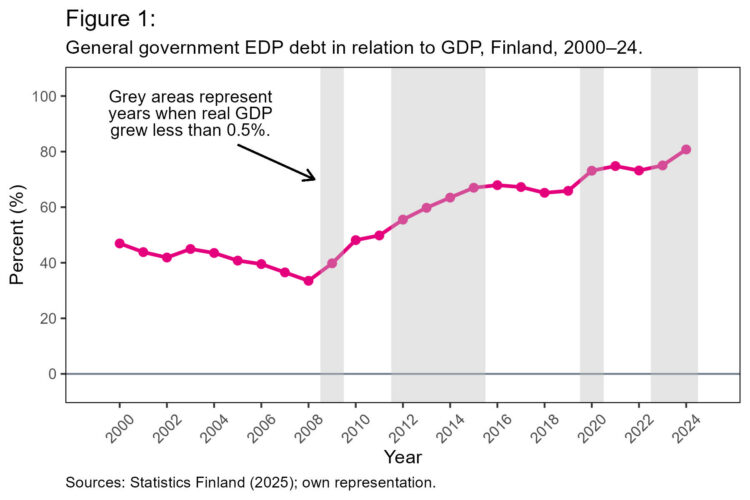Finland’s four-party right-wing coalition, led by Prime Minister Petteri Orpo, has proposed adopting a national debt brake that would cap public debt at 40 percent of GDP. From 2031 onwards, the debt-to-GDP ratio would need to fall by at least one percentage point annually until reaching this ceiling. With Finland’s public debt currently approaching 90 percent of GDP, this would necessitate fiscal consolidation for roughly fifty years — and only if economic conditions remain favourable.
The proposal significantly exceeds the stringency of the European Union’s fiscal framework, which sets its debt ceiling at 60 percent of GDP. Under EU rules, member states with debt ratios between 60 and 90 percent must reduce them by at least 0.5 percentage points annually. Only when the ratio exceeds 90 percent does the annual adjustment requirement rise to one percentage point.
As part of the debt brake, the Finnish government also plans to exclude social security funds from public deficit calculations. Since these funds typically run surpluses, their exclusion would artificially increase the likelihood of triggering additional consolidation measures. Between 2010 and 2024, this accounting change alone would have added €27.1 billion (in 2024 prices) to consolidation pressures — more than Finland spent on social and healthcare services in 2024.
At a time when countries such as Germany have begun acknowledging the dangers of excessively tight fiscal rules, Finland’s right-wing government seeks to bind future administrations to austerity aligned with its political agenda. Such a course would not only weaken the Finnish economy but also worsen public indebtedness.
Excessively Tight Fiscal Rules Will Compound Finland’s Economic Problems
The government’s argument rests on the assumption that consolidation ensures debt sustainability. However, Finland’s rising public debt stems not primarily from excessive fiscal spending but from prolonged economic underperformance. Between 2000 and 2024, 70 percent of the increase in Finland’s debt-to-GDP ratio occurred when annual growth fell below 0.5 percent, with a further 23 percent arising in the immediate aftermath as unemployment continued rising.

This pattern implies that the proposed debt brake would activate mainly during downturns — precisely when consolidation most damages demand and growth. It therefore risks locking the economy into a vicious cycle of weak growth and rising debt ratios.
Compounding the problem, the Finnish government has pledged under NATO commitments to double military expenditure to 5 percent of GDP by 2035. The EU’s national fiscal policy escape clause applies until the end of 2028, meaning this additional defence spending will not count towards EU rules until then. But under tighter fiscal rules, higher military spending from 2029 onwards will require further fiscal consolidation.
Whilst the government aims to introduce national fiscal rules stricter than the EU’s, the EU’s revised framework already obliges Finland to implement €9 billion in consolidation between 2025 and 2031. A report published in April by the Finnish Centre for New Economic Analysis (UTAK) applied the European Commission’s debt sustainability model to estimate these measures’ impact on Finland’s real GDP and debt ratio.
Using mid-range fiscal multipliers from academic literature, the study found that by 2031 the consolidation package would result in seven years of stagnation and leave the debt-to-GDP ratio higher than without consolidation. Since the proposed debt brake would require far more consolidation than EU rules, its negative economic impact would prove considerably more severe.
The national debt brake thus risks locking Finland into a self-defeating austerity cycle. Rather than restoring confidence in public finances, excessively tight rules risk eroding the country’s economic and social foundations whilst hampering the investment and growth needed to reduce the debt ratio.
Strengthening Domestic Demand Holds the Key to Solving Finland’s Predicament
The current government has already committed to spending cuts and tax increases amounting to roughly €9 billion in gross terms by 2027 — equivalent to around 5.5 percent of overall public expenditure this year. The bulk of these measures target social security benefits and social and healthcare services. According to the Finnish Institute for Health and Welfare, the social security cuts implemented in 2024–25 alone are expected to push an additional 110,000 people into poverty, including 27,000 children.
The consolidation measures are aggravating not only social problems but also economic ones. Contrary to broader economic trends in the EU, Finland’s downturn has persisted since late 2022. In this year’s second quarter, unemployment amongst 15–74-year-olds rose to 10.2 percent, whilst the economy shrank by 0.4 percent in real terms.
With significant reductions in disposable incomes for low- and middle-income households — groups with relatively high propensities to consume — private consumption has unsurprisingly become the main drag on the economy, falling by 1.3 percent.
This predicament highlights how little Finnish policymakers have learnt from the country’s long stagnation over the past 17 years. In the 1990s and 2000s, growth depended heavily on international demand, largely driven by Nokia’s global expansion. After the 2008–09 financial crisis and Nokia’s collapse, however, the large current account surpluses disappeared and the economy became dependent on domestic demand.
With real wage growth stagnating, household consumption has proved too weak to sustain firms’ inducement to invest. As a recent report by McKinsey noted, Finnish firms have increasingly preferred distributing dividends to shareholders rather than expanding productive capacity. This has, in turn, hurt exports by making Finnish products less complex and less competitive internationally.
The proposed debt brake would only worsen Finland’s challenges by further weakening domestic demand. A sustainable recovery instead requires higher public investment, greater disposable income for low- and middle-income households, and stronger real wage growth — measures that would help restore firms’ confidence and willingness to invest. With such dynamics in place, the debt ratio would also decline.
Otto Kyyrönenserves as Chief Economist at a Finnish non-governmental organisation.

